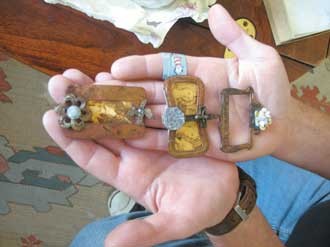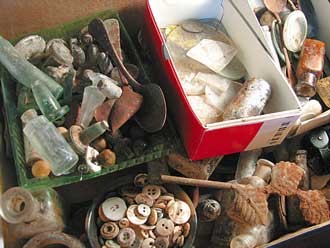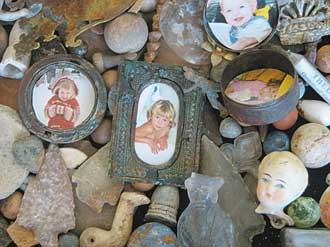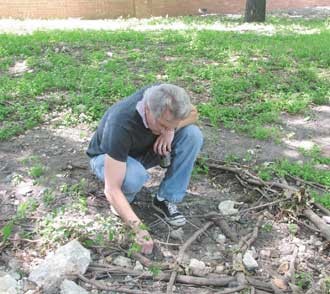Doug Gilmour finds treasure nearly everywhere he walks
Once upon a clear evening, Thales, a pre-Socratic Greek philosopher, was led from his home by an elderly woman who invited him to observe the stars. Gazing up at the night sky, the philosopher forgot to mind his footing and fell into a ditch. In agony, he wailed and moaned. “Do you, O’ Thales,” asked his unsympathetic guide, “who can not see what is under your feet, think that you shall understand what is in heaven?”
| Doug Gilmour, left, collects the treasures he finds while out walking and makes them into objects d’arte. |
Perhaps hoping to avoid Thales’s fate, Incarnate Word philosophy professor Doug Gilmour spends several hours a week staring at the ground; if the earth does not reveal its secrets, it sometimes reveals its buried treasures. Gilmour has a crazy knack for finding cool old stuff on the street and in creeks, fields, and drainage ditches: a tin soldier and his horse, an 1898 quarter, a flirty “Drink Nehi” bottle opener in the shape of a lady’s shoe and beribboned sock, even the occasional jeweled cufflink. Like a modern day mudlark, he collects these odds and ends, donating what is historically valuable, and keeping the rest.
| Doug Gilmour |
“It’s like I can’t keep it from finding things,” Gilmour says. “It’s become kind of a joke in my life. It’s weird because I never found things as a kid.”
That changed about 20 years ago, while Gilmour was finishing up graduate school at Duke University in North Carolina. It was a difficult time: He had just returned from traveling in Berlin to the intense work of his dissertation on Neitzche, and he had simultaneously ended a long relationship and lost his best friend. As the young philosopher turned inward, he began taking long walks on an old tobacco farm. “I kept finding Civil War buttons and artifacts,” he explains, “and all that stuff was speaking to me, you know, in that same way that music can make you cry. So it was partly sad, maybe partly trying to get something back, but — and I would almost have to use poetry to describe it — there was a deep, deep joy in it also.”
| A shoebox filled with delicious old buttons, glass stoppers, and silver spoons is stored for another day. |
“It was as if something came over me,” he adds. “I could walk across Duke’s campus and there would be a thousands-of-years-old arrowhead staring up at me.”
Although Gilmour still finds things on the street, there are several fertile (and secret) spots around town that he frequents, stopping to poke around for half an hour “when I want to be by myself and quiet,” he says. “Half the time I don’t find a thing, but it’s very meditative to walk slowly and look at the ground.”
| baby-doll parts are enshrined in a velvet-lined case. |
One morning, we visit one of his regular haunts, an eroded drainage ditch well-nigh glimmering with shards of vintage glass and porcelain. Gilmour is opposed to metal detectors and digging. Instead, he squats close to the ground, covering about a yard every 10 minutes in a modified crabwalk, using an old, square, steel-cut nail to leverage desirable treasure out of the dry topsoil.
Within five minutes of our arrival, Gilmour has found the rusty remains of a choo-choo train, a metal button (“It’s too corroded to see if it’s anything good, but I’ll take it home and clean it up,” he says, hopefully.), a marble, and the rosy cheek and lips of a porcelain baby doll. Looking in those same spots, I find only a nail and an electrical insulator, but I’m inspired — nay, manic! — in my looking.
| Doug Gilmour is philosophically opposed to using metal detectors or digging up treasure. Instead, he uses an square-cut nail, long and rusty, to flick his finds out of the dirt. |
“It’s not just a matter of looking; he’s like a water diviner,” says Gilmour’s wife, Amy Ritthaler Gilmour. On one of their early dates, Doug took her to a site in Kendalia where he’d found fossils and artifacts. As they ambled around, he kept picking things up, but she could find nothing. “He said, ‘Stand right here; in this 7-foot radius there’s a beautiful treasure,’” she relates. “Well, I looked for 15 minutes, thinking ‘Oh my God, he’s going to think I don’t have the touch.’ It was by my foot. He just bent down and flicked it up: You have to look for the edge, not the whole piece.”
Gilmour says he has the best luck after a hard rain and, on our walk together, a fresh squirrel hole elicits, “Oh all right, man, let’s see what they got for us!” As it turns out, the squirrel has chucked aside an opalescent bottle and a oyster shell, which makes me wonder, what is treasure? While the bottle is a neat, but not thrilling, find for Gilmour, some — including the nut-hunting squirrel — would label it garbage. “I always think the things I find contain some kind of energy,” Gilmour says. “That’s a flighty spiritual thing I can’t defend philosophically, but I think it’s important poetically. I know there’s an incredible story in all these objects if you just had the time to extract it.”
| O man, take care! What does the deep midnight declare? I was asleep From a deep dream I woke and swear: The world is deep, Deeper than the day had been aware. Deep is its woe; Joy — deeper than the heart’s agony: Woe implores: Fade! Go! But all joy wants eternity — wants deep, deep eternity. Nietzsche |
Gilmour is as enchanted by old marbles — which he believes carry the playful spirit of children — as he is by an ornate 1920s medal labeled “National Motorcycle Gypsies” or a petrified shark’s tooth. “I don’t know how much archeological significance these objects have,” he admits. “But what comes up, I feel I can pick up because I preserve it and I know where it all comes from — I could take you to the very spot.”
Still, over the years, Gilmour has found treasures he couldn’t keep. Mucking around in the Thames River, Gilmour found a life-size stone hand, which he promptly gave to the Museum of London. And, in the Incarnate Word soccer field, he has found more than 140 artifacts, including Paleolithic arrow-points, musket balls, and a matate (a grinding stone). Gilmour researched, numbered, and archived all the objects (“I’m only an amateur,” he says, “but I provided tentative descriptions in the hopes that someone will come in and do something definitive.”) and presented them to the Sisters of Charity at Incarnate Word. Most recently, they were used at the university’s Headwaters Symposium to support the historic value of the land around the Blue Hole, where the San Antonio River’s headwaters meet Olmos Creek.
So what does Gilmour do with the treasures he keeps? In his garage there’s a tidy workshop, where corroded chunks of metal are cleaned in a vinegar bath and made into objects d’arte. Old metal frames are pounded straight and adorned with found objects — cloisonné flowers and glass rubies — and filled with photos of his children. Gilmour photographed a postcard of Our Lady of the Way, water-stained and pockmarked with rubble, and put the reproduction in a heavy clock-housing for display.
A long, black-velvet-lined wood case holds his collection of tiny porcelain baby dolls. The dolls are more than a little worse for the wear: Some are reduced to a single pale arm or chubby leg — or worse, an ear. Yet they are delicious in their creepiness, and easy to covet.
Despite my desperate wish to do so, I never found a baby doll in the drainage ditch, but I did experience the meditative side of searching for one; so intent was my focus on the ground, that everything else receded, and I eventually felt a little dizzy. “I don’t take people out with me too often,” says Gilmour. “It can be really frustrating, but it can also make you a little sick.”
Although Gilmour has experienced his own periods of frustration — a summer without rain is a summer without treasure, and a long drought once drove him to scoot down a drainage pipe in search of something, anything — he mostly attributes the success of his rambles to his own state of mind, his openness to the objects. “Sometimes I have the most incredible eyes,” he says. “Sometimes I don’t see anything at all, other times stuff’s just jumping out at me.”





















